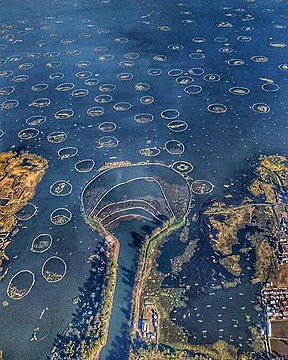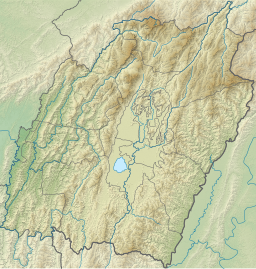| Loktak Lake Meitei: Loktak Pat | |
|---|---|
Different scenes of the Loktak lake of Manipur | |
| Location | Manipur |
| Coordinates | 24°33′N 93°47′E / 24.550°N 93.783°E |
| Type | Fresh water (lentic) |
| Primary inflows | Manipur River and many small rivulets |
| Primary outflows | Through barrage for hydropower generation, irrigation, and water supply |
| Catchment area | 980 km2 (380 sq mi) |
| Basin countries | India |
| Max. length | 35 km (22 mi) |
| Max. width | 13 km (8 mi) |
| Surface area | 250 to 500 km2 (97 to 193 sq mi) |
| Average depth | 2.7 m (8.9 ft) |
| Max. depth | 4.6 m (15.1 ft) |
| Surface elevation | 768.5 m (2,521 ft) |
| Islands | Thanga, Ithing[page needed], Sendra[page needed] islands. Also many floating islands called phumdis or phumshangs |
| Settlements | Imphal & Moirang |
| Designated | 23 March 1990 |
| Reference no. | 463[1] |


Loktak Lake (Meitei: Loktak Pat[2][3][4]) is a freshwater lake in Northeast India. It is a pulsating lake, with a surface area varying from 250 km2 to 500 km2 during the rainy season with a typical area of 287 km2.[5] The lake is located at Moirang in Manipur state, India.[6] The etymology of Loktak is Lok = "stream" and tak = "the end" in Meitei language (Manipuri language).[5][4] It is famous for the phumdi (heterogeneous mass of vegetation, soil and organic matter at various stages of decomposition) floating over it. The largest of all the phumdis covers an area of 40 km2 (15 sq mi) and is situated on the southeastern shore of the lake. Located on this phumdi, Keibul Lamjao National Park is the only floating national park in the world. The park is the last natural refuge of the endangered Sangai (state animal), Rucervus eldii eldii or Manipur brow-antlered deer (Cervus eldi eldi), one of three subspecies of Eld's deer.[7][8]
The Loktak Day[page needed] is observed every year on the 15th of October at the periphery of the Loktak lake.
This ancient lake plays an important role in the economy of Manipur. It serves as a source of water for hydropower generation, irrigation and drinking water supply. The lake is also a source of livelihood for the rural fishermen who live in the surrounding areas and on phumdis, also known as "phumshangs". Human activities have led to severe pressure on the lake ecosystem. 55 rural and urban hamlets around the lake have a population of about 100,000 people.[7][8][9][10] Considering the ecological status and its biodiversity values, the lake was initially designated as a wetland of international importance under the Ramsar Convention on 23 March 1990.[6] It was also listed under the Montreux Record on 16 June 1993, "a record of Ramsar sites where changes in ecological character have occurred, are occurring or are likely to occur".[11]
- ^ "Loktak Lake". Ramsar Sites Information Service. Retrieved 25 April 2018.
- ^ Tamang, Jyoti Prakash (2 March 2020). Ethnic Fermented Foods and Beverages of India: Science History and Culture. Springer Nature. p. 353. ISBN 978-981-15-1486-9.
- ^ Lisam, Khomdan Singh (2011). Encyclopaedia Of Manipur (3 Vol.). Gyan Publishing House. p. 589. ISBN 978-81-7835-864-2.
- ^ a b Ramachandran, Nalini (3 September 2021). Gods, Giants and the Geography of India. Hachette UK. p. 105. ISBN 978-93-91028-27-5.
- ^ a b Khwairakpam Gajananda; Thokchom Sundari Chanu. "The Fate of Loktak Lake". Retrieved 3 April 2009.
- ^ a b "Integrated Wetland and River Basin Management – A Case Study of Loktak Lake". Wetlands International - South Asia, New Delhi, India. Archived from the original on 22 March 2012. Retrieved 3 April 2009.
{{cite web}}: CS1 maint: unfit URL (link) - ^ a b "Loktak Lake". WWF India. Archived from the original on 21 February 2010.
- ^ a b "Bishnupur: The Land of the Dancing Deer". National Informatics Centre, Government of India. Archived from the original on 10 April 2009. Retrieved 7 December 2018.
- ^ "Developmental Activities and their Impacts on Wetlands". Archived from the original on 27 July 2011. Retrieved 3 April 2009.
- ^ "Loktak Lake Environment Information system (ENVIS)". Archived from the original on 16 December 2007. Retrieved 3 April 2009.
- ^ "The Montreux Record". The Ramsar Convention. 8 September 2009. Retrieved 4 April 2009.






